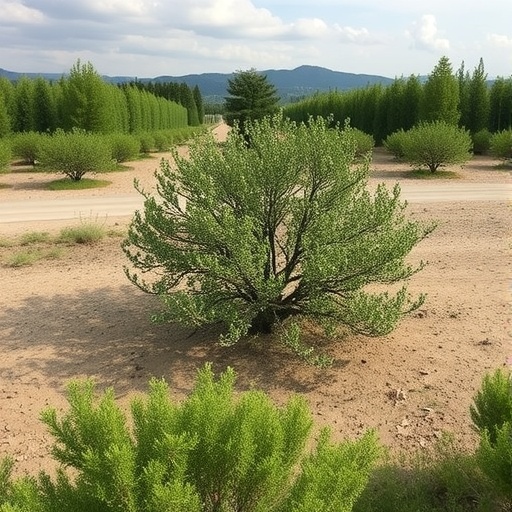Rising atmospheric dryness has emerged as a significant factor that is profoundly influencing the terrestrial ecosystem carbon cycle. With the increasing trends in atmospheric vapor pressure deficit (VPD) acting as a proxy for atmospheric dryness, the implications for plant physiology and carbon dynamics in our ecosystems cannot be overstated. Atmospheric VPD, which gauges the amount of moisture the atmosphere can hold relative to the moisture present, has seen a notable rise since the late 1990s. This increase, at a mean rate of approximately 0.0155 hPa per year, indicates a shift in environmental conditions that poses challenges to our vegetation and the larger carbon cycle.
The connection between VPD and plant performance is critical. Plants rely on a delicate balance of moisture for various physiological processes, including photosynthesis, transpiration, and nutrient uptake. A rise in VPD signals a higher gradient between the moisture available in the soil and the moisture in the air, leading plants to experience increased rates of transpiration. This heightened transpiration can result in reduced leaf area index, a crucial metric that reflects the total area of plant leaves per unit ground area. Studies have revealed an approximate reduction of 0.11 m² m⁻² hPa⁻¹ between 1982 and 2015, underscoring the negative impact of rising VPD on plant health and vitality.
Furthermore, this increase in atmospheric dryness comes with direct repercussions on gross primary production (GPP), a vital indicator of the photosynthetic capacity and carbon fixation of ecosystems. Data indicate that between 1982 and 2015, GPP has shown a reduction of about 13.82 PgC hPa⁻¹, primarily associated with diminishing leaf area and the stress imposed by higher VPD levels. Such changes pose a significant threat to overall ecosystem productivity, particularly in regions where water resources are already limited.
In addition to growth rate impacts, the light use efficiency of plants—how effectively they convert sunlight into biochemical energy—has similarly decreased under rising VPD conditions. From 2001 to 2020, studies documented a decline of about 0.04 gC MJ⁻¹ hPa⁻¹ due to increased atmospheric dryness. This raises a crucial concern, as the efficiency of primary producers plays an integral role in sustaining the food web, thus affecting all levels of the ecosystem.
Another critical aspect influenced by VPD is net ecosystem production (NEP). This measure encompasses the net amount of carbon storage in ecosystems following photosynthesis and respiration. Between 1982 and 2013, a reduction of around 5.59 PgC hPa⁻¹ in NEP was noted, raising alarms about the capacity of terrestrial ecosystems to sequester carbon effectively. As the carbon cycle is delicately poised on the interactions between photosynthesis, respiration, and decomposition, any shift in NEP can create a ripple effect that exacerbates climate change scenarios.
The challenges in linking changes in the terrestrial carbon cycle directly to VPD are substantial. Multiple environmental factors, such as soil moisture levels, temperature shifts, and varying levels of solar radiation, simultaneously influence ecosystem performance and productivity. This interplay complicates our understanding of the specific roles that rising VPD plays in modulating these complex systems. Moreover, it is essential to recognize that the response of plants to rising VPD is not homogeneous, with different species exhibiting variable sensitivity to changes in atmospheric moisture levels.
Various physiological mechanisms underlie plant responses to VPD that merit attention. Stomatal closure is one of the primary protective responses that plants employ to minimize water loss under dry atmospheric conditions. While this mechanism helps conserve moisture, it simultaneously limits carbon dioxide uptake, ultimately stunting photosynthesis and growth. Other significant responses include hydraulic failure—where the plant cannot transport water efficiently through its vascular tissues—and increased abscisic acid biosynthesis, a hormone that prompts stomatal closure and a range of stress responses.
Moreover, the cascading effects of VPD on fire occurrence and soil moisture deficits have profound implications for carbon cycling and ecosystem sustainability. For instance, rising VPD levels can lead to drier landscapes, which increases the frequency and severity of wildfires. These events not only disrupt carbon storage and release significant amounts of carbon dioxide but also promote further decomposition of organic matter in soil, exacerbating the carbon cycle disruption.
Given the complexities and interconnections of these factors, the path forward for researchers is clear. Prioritizing global VPD-manipulation experiments could significantly enhance our understanding of the feedback mechanisms between VPD, plant behavior, and the overarching carbon cycle. Such controlled studies would allow scientists to isolate the impacts of VPD from confounding variables, giving them a clearer picture of how global drying trends may reshape terrestrial ecosystems and their roles in the carbon cycle.
Integrating insights gained from VPD-focused experiments into terrestrial carbon cycle models represents a critical step forward in accurately predicting ecosystem responses to ongoing climate changes. Current models often lack the nuanced understanding needed to account for the variability in plant responses to atmospheric dryness, leading to suboptimal predictions about future carbon dynamics. Therefore, improving these models to incorporate data from VPD-manipulation studies will be essential in making informed decisions about ecosystem management and climate change mitigation strategies.
In conclusion, the rising atmospheric dryness and its associated increase in vapor pressure deficit present significant challenges to the terrestrial carbon cycle. As research continues to unfold, the ramifications of these changes on plant physiology and ecosystem carbon dynamics will demand increased attention from the scientific community. Dedicating resources to understand the intricate connections between VPD and the terrestrial carbon cycle will be pivotal in navigating the uncertain future of our planet’s ecosystems.
Subject of Research: The impact of rising atmospheric dryness on the terrestrial ecosystem carbon cycle.
Article Title: Impacts of rising atmospheric dryness on terrestrial ecosystem carbon cycle.
Article References:
Yuan, W., Tian, J., Wang, M. et al. Impacts of rising atmospheric dryness on terrestrial ecosystem carbon cycle.
Nat Rev Earth Environ (2025). https://doi.org/10.1038/s43017-025-00726-2
Image Credits: AI Generated
DOI: 10.1038/s43017-025-00726-2
Keywords: Vapor pressure deficit, terrestrial carbon cycle, plant physiology, atmospheric dryness, ecosystem productivity, climate change.




